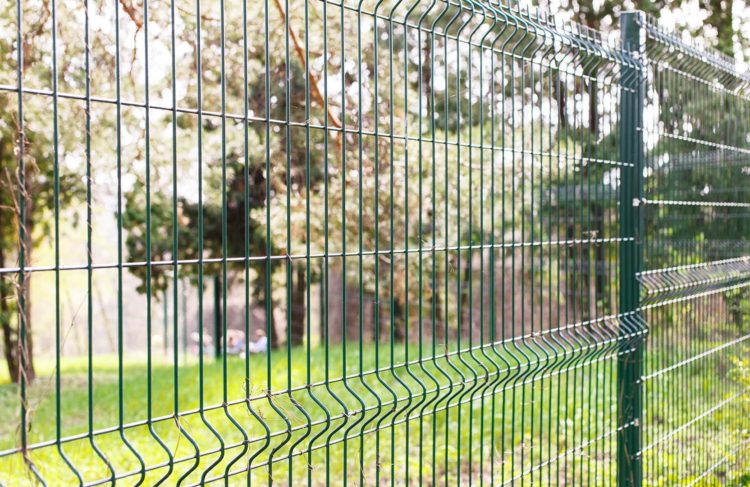When we purchased our first home in more than a decade, we hoped to get something with space to grow. Our goal was to have some land, at least 2,000 square feet, and not many improvements to make.
We got lucky in the BC (before COV**) world. A home went for sale two days before the lockdown occurred.
Our offer got accepted, we got the mortgage finished the day before transactions were stopped. We moved in feeling like we had won the lottery.
Our wish list wasn’t entirely fulfilled. The property had no fencing, and restrictions at the time didn’t allow for contractors to provide services.
That meant learning how to install a fence myself so that we could have a garden and a place for the dogs to run free. It became a crash course in learning the differences between T-posts and U-posts.
T-Posts versus U-Posts
The difference between T-posts and U-posts depends on the shape of the entry blade at the end of the post. Each has a primary function to support the fence, but T-posts tend to have a sharper point. That’s why T-posts are typically used for poultry fencing, while U-posts are more for livestock.
Before starting any fencing project, you’ll want to call 811 or whatever other numbers locally provide ground inspection services.
You don’t want to hit a gas or a water line when pounding in your fence posts.
Once you’ve scheduled that appointment or service (you don’t usually need to be there unless your property doesn’t have access), it’s time to find the fence posts and barrier materials required for the project.
T-posts and U-posts are virtually the same. The only difference is the shape of the entry blade that locks the post into place after it’s driven into the ground.
A T-post has a sharper anchor point and might be taller, while the U-post anchor is more rounded and shorter.
That’s why you don’t want to use T-posts for anything except poultry or perhaps a field barrier that isn’t being used as a pasture. Since we wanted a space for our dogs to run while keeping pests out of a garden, we opted to invest in U-posts to use.
Here are the items you’ll need to have a successful post installation.
- Fence Post Driver. Although you can use a sledgehammer to install T-posts or U-posts, I found it was much easier to use the MixxIdea Fence Post Driver. It is a hollow tube, made from steel, that fits over the post. You lift it up, ram it down, and repeat until the post reaches the correct installation height.
- Tall Metal Fencing. When you start shopping for hardware cloth, fencing wire, or poultry barriers, you’ll find that most products are only three or four feet high. Our dogs would jump right over that. We decided to use Jobe’s Easy Gardener 7-foot barrier fencing instead.
- Fencing Ties. We used chain-link fence self-locking ties to secure the fencing material to each post. Although you could use zip ties for that work, we wanted something more secure. You’ll want to review the manufacturer’s instructions for your materials first to ensure you’re not inadvertently damaging the fence with inappropriate anchors.
Once you’ve gathered the supplies and had your property inspected, you’ll be ready to start installing your T-posts or U-posts.
Both designs install the same way.
How to Install T-Posts and U-Posts Straight
When you’re ready to start building a fence, the first step to installing a straight T-post or U-post is to ensure each corner is braced and set. I found it helpful to establish a guiding line to ensure we stuck to the property boundary.
Keep the anchor plate at the bottom and perpendicular to the fence.
With the fence post driver, you can pound the posts downward from an ideal vertical angle. Although you can use a hammer to do the same thing, you’re less likely to miss with the driver in your hands.
Each post needs to go into the ground at least 18 inches. If the points stand up from the ground, they could injure animals or your family – or get dislodged if someone or something leans on the T-post or U-post too much.
Keep referring to your guiding lines while working. The goal is to install all the posts first. You can place the fencing around them after everything else is anchored.
T-posts and U-posts use PSI ratings to determine their strength. I’ve found that the best post designs provide a tensile strength rating of 80,000 PSI or higher.
Anything less won’t keep out those larger pests (I’m looking at every one of you deer out there right now!).
Can I Use Barbed Wire Fencing with T-Posts and U-Posts?
When my family and I started designing our fence, we decided that barbed wire wasn’t the best option for our needs.
We needed something that would keep small and large pests out of the garden while having a barrier that didn’t hurt the dogs.
If you’re building a fence for a pasture, it makes sense to use barbed wire. You can also separate different spaces on a farm with this affordable fencing option.
You can find two-point and four-point options available. I prefer the latter because you’ll have a more resilient barrier.
Our neighbor uses Tapix Four-Point Razor-Barbed fencing to protect his property. He does hobby farming, so he manages pigs, goats, cattle, and horses in different sections. It does a great job of keeping those animals secured without needing a firmer barrier.
Why Can’t I Build a Straight Fence with T-Posts or U-Posts?
I’m not the tallest person around. We bought six-foot posts to install for our fence, which meant the post driver was above my head for several repetitions before the installation was secure.
It didn’t take long for me to notice that I was pulling the post toward me each time I’d raise the driver after banging it down. That action creates a slanted drive that eventually results in a crooked fence.
We had to invest in a stepladder to correct the issue. I also recommend finding some no-slash gloves and sleeves to protect your hands and arms during the installation process, like the Schwer Store Stainless Steel Wire Metal Mesh Butcher Gloves.
Once you get into a rhythm, you’ll find that the rest of the installation process is relatively smooth.
Try to space the posts about four to six feet apart for the best results, although it often depends on what fencing material you’re using.
When Are U-Posts a Better Choice Than T-Posts?
If you plan on having a fence over four feet tall, you’ll want to use T-posts to secure the barrier. The extra strength will help you control pests or prevent animals from escaping.
When you have a light-duty or temporary fencing need to manage, U-posts are a better solution in most circumstances.
The secret to success with these posts is to purchase a product that is at least one foot taller than your fence.
If you install a three-foot poultry wire fence, you’d want to install a four-foot U-post or taller.
We decided to use U-posts to install fencing for some of our flower beds and root vegetables. When you look at each post, you’ll see that it comes with an anchor plate welded to the bottom, just like a T-post.
The anchor prevents the post from moving freely once it’s installed.
Here are the steps to follow if you’re using U-posts and a shorter fence to protect different property areas around your home.
- Ensure the space where you plan to work doesn’t have any underground pipe or wires you could damage. Even if you’re in the middle of an open field, you never know what might have been routed through there before.
- Measure the perimeter for the installation point. You’ll want to confirm that you have more fencing materials to use than the length you need.
- Install the first U-post at one end of the perimeter. Unlike T-posts that use a fence driver, a U-post installs better with a rubber mallet. It should go about one foot into the ground to ensure the anchor plate is below the sod or dirt line.
- Install the second post at the other end of your perimeter. The tabs should be facing in the same direction with each post.
- Depending on your fence length, you’ll install more posts at five-foot or seven-foot intervals. When you have the posts evenly spaced, it’ll create a fence that looks more visually appealing.
- After the U-posts are installed, you’re ready to start putting up the barrier. I’ve found that it helps to unwind your garden fencing on the ground instead of trying to hook it up while in a roll.
- Start at the first post you installed. Hook the fence onto the tabs. You might need to bend them a little outward to get the item to fit. It helps to have a large flathead screwdriver to help with this task.
- The fence should touch the grass or ground. Continue along the perimeter. If you have corners to navigate, carefully bend the fencing material around the U-post installed.
- Keep repeating at each post until the fence is entirely in place and hooked to each post.
- If your design has less length than the fencing material purchased, you can use side cutters or similar tools to trim it to size. Bend the cuts to prevent them from having sharp corners that could hurt others or animals.
When Do I Need to Install a Fence?
T-posts and U-posts create fencing options that don’t typically involve privacy. The goal is to create a sturdy barrier that protects private property while supporting daily activities. Most jurisdictions require a permit before starting a project like this, so check local building codes before investing in materials.
I had a unique situation with my fence. Our home is within the city limits of our community, but it is also relatively rural. The neighbors are about a half-mile away.
Since we’re within the city limits, I had to secure a building permit to construct my fence. If you go three miles down the road, that restriction disappears.
The issue was the deer fence since it was seven feet tall. The city didn’t care about the garden fence that was a little over three feet tall.
It’s always better to be safe than sorry when focusing on home and property improvements. If you plan to construct the fence on a property line, I highly recommend having a surveyor determine the boundary to avoid potential problems in the future.

